

Adios, San Juan!
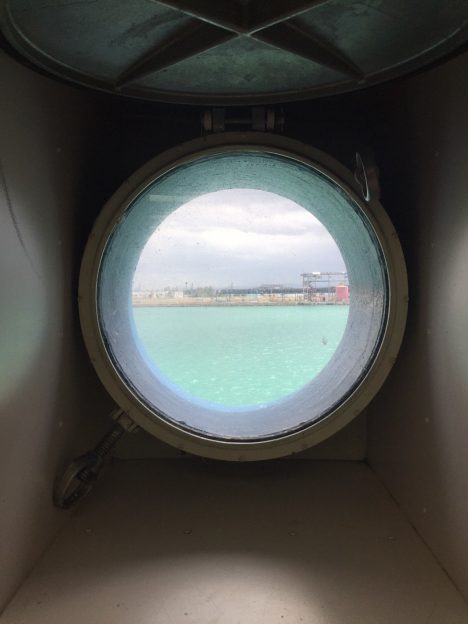
View of the water from a porthole in the main lab on board the R/V Atlantis
Today, we said goodbye (or rather adios) to the port of San Juan and hello/hola to the Atlantic Ocean. The past few days have been a whirlwind of unpacking, setting up our gear, securing our gear, mounting sensors, stretching cable from one end of the ship to the other, testing instruments, attending safety briefings and science meetings, meeting our fellow scientists and getting to know the crew…all while trying to fit in some exploring in Old San Juan and soaking up the Caribbean sun and sea while we can! After working for most of the day in the hot sun, carrying boxes in and out of labs and pinning sensors to the highest possible points on the ship, it was a treat to walk just a few blocks from the ship to a public beach with a protected inlet for swimming a few laps in the crystal clear ocean. As if this beach could get any more picturesque, after passing showers in the afternoon, the scene was perfectly set for a rainbow over the horizon. We oceanographers are certainly lucky when our work takes us to such stunning places.
This morning (after one last ocean swim for the dedicated masters swimmers J), we waved goodbye to the fans and helpers who came to see us off. We sailed out of the Isleta de San Juan, where R/V Atlantis has been docked for the past several days, past the old fort, and into deeper waters. Once underway, we practiced muster drills to know where to go and what to do in the unlikely event of an emergency. The science team has never looked more glamorous than when we all donned our immersion suits together—30+ people getting used to the new roll of the boat, bumbling around in our gumby suits. Let’s hope someone took a picture.
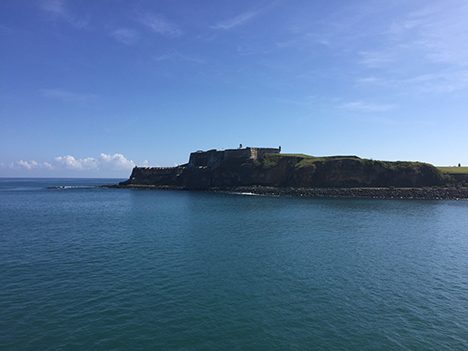
View of an old fort as the R/V Atlantis sailed out of the Isleta de San Juan towards deeper waters.
With Puerto Rico fading into the background, we watched the water color change from the bright, milky turquoise (filled with the occasional reef fish or even an octopus darting under the ship last night!) of the inland lagoon to a deep azure dotted with whitecaps. As a member of the Optics Team onboard NAAMES 4, my lab mate James Allen and I are always interested in characterizing the color and brightness of the ocean to tell us more about what is in the water. When we get on station in a few days, we will use a number of different sensors to tell us about the light hitting the surface of the ocean and how that light is absorbed and scattered by water and other things as it travels to depth. We have sensors mounted on the ship to measure the light coming from the sun, and we will send other instruments down into the water to describe the concentration of phytoplankton and other particles.
We may have said farewell to the rocky reefs and white sands of San Juan, but there was a perceptible air of excitement from everyone on the ship as we finally started to move. Now, with dreams of spring blooms and calm seas (not likely, but we can dream!), we face our next adventure: the North Atlantic!
Written by Sasha Kramer
In 30 days I’ll be a salty veteran. I’m going out to sea for 3 1/2 weeks with a group of scientists I’ve never met, a fellow lab mate, and a professor from Rutgers. We’re traveling to the North Atlantic to cleverly observe the largest assemblage of phytoplankton on our planet. I’ve heard these research expeditions are grueling – not much sleep every night, waking at impossible hours (11pm), and intense sampling work every day for weeks on end. However, as I become accustomed to the ship and the crew of scientists, engineers, and deckhands as we set up our mobilized laboratory, I can feel the sense of community and warmness, not of stress and hardship. My lab mate hugs every scientist he knows as he sees them for the first time since the last expedition, and I meet scientists from around the USA. Exuberant scientists from different labs are explaining how their instruments work to others, just for the sake of learning.
Each scientists knows their duty – to propel their minds past the limits of what they know about their surroundings, and report back. However, even amongst the high level of expertise and knowledge of professors and NASA employees, I don’t feel a sense of competition.

View of the R/V Atlantis from the San Juan, Puerto Rico dock
Today, docked in San Juan, we prepare for deployment, and diverse groups of scientists bond over beer after work. Some set up planes which fly by our ship when it will venture into the Atlantic, and collect cloud samples. Some are constructing scaffolds which collect the mist pushing off of the sea surface. Our lab collects samples of seawater at various depths. Each lab has sent out experts in their field, taking as many samples as they can.
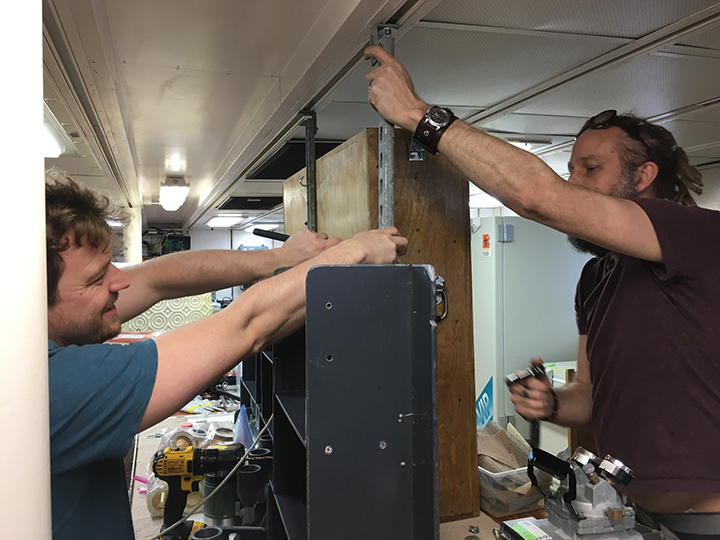
Ben Diaz (left) and Kay Bidle (right) making the dream work
When it’s over, it’s up to each lab group to coordinate with other scientists and piece together a picture of what’s happening. Can phytoplankton influence cloud formation? Is it possible that this mass of phytoplankton contributes to what we call seasons? How do different particles or plastics found in seawater influence the interaction between phytoplankton and the atmosphere? We don’t know how the pieces will come together just yet, but we all love the process.
Written by Ben Diaz
There and back again
Of course, a title stolen from ‘The Hobbit’ but appropriate just the same. It’s Monday afternoon and the Atlantis is once again tied up to the dock. We came in yesterday on the early morning tide and quickly began the task of ‘demobilization’ – i.e., unloading the tons of scientific gear that were set up on the Atlantis for NAAMES III. It’s remarkable how quickly all that gear can be packed, labels, offloaded, and sent to shipping when demobilization is the one thing standing between 30+ scientists and their trips home. It is a keen motivator to say the least. Only a day and a half after arriving, the labs are shockingly empty. The cramped spaces once filled with instruments, wires, tubing, sampling equipment, and myriad other widgets and gadgets are now empty spaces that echo your voice. The final tasks is sweeping and mopping and then NAAMES III is finished.
Earlier in this trip, one of our bloggers mentioned the duality of time during an ocean voyage. On one hand, exact timing is essential to successful experimentation and for keeping activities running smoothly on a very busy schedule. On the other hand, time seems to hold little meaning as the days blur together and weeks pass with little recognition. This duality is particularly pronounce when the voyage is done. The memory of untying the ship and heading out to sea is still so vivid in our minds that it is seems impossible to accept that nearly a month has passed. On the other hand, it seems equally impossible that the sum of all those endless days and sleepless nights has only amounted to a few weeks.
If you have followed this blog over the past month, I suspect you have both gained a greater appreciation for the science of the NAAMES project and enjoyed some insights on the personal experiences associated with going to sea. A temporary family is always created during these expeditions, but when it is over that family must disperse and return to their normal lives. Today, we are beginning to say our farewells, but the science we do will keep this family attached for a long time to come. NAAMES III has been a tremendous success, and that success is fully attributable to the individuals who have taken part in this adventure, both the scientists and the crew of the Atlantis. It is an amazing team. We have gone there and come back again. I will end this blog as I have during previous NAAMES campaigns in saying that it is the names of NAAMES that set this mission apart.
Written by Michael Behrenfeld
Near Oceans End
This cruise is all but over and at this time tomorrow I will be several beers deep in the aftermath of the end of cruise party.
Meantime I promised that sweet heart, Kristina, that I would write a BLOG … so here you go sister :).
There is something about standing on and ocean-going ship. Sure footed for the moment. Gaze cast on an endless horizon of deep blue water against a pale blue cloud feathered sky. That gives me full focus on the enormity of our planetary home and life support system. All life that we know about is here. Full stop…
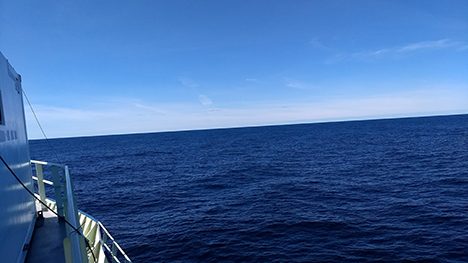
Starboard view on board the R/V Atlantis
Such clarifying moments buffer me against a dry land back drop of emotionally charged “discussions” of climate and resources.
It re-invigorates my drive to do my part in the difficult job of characterizing this planets vital composition.
I take ever increasing pride in my role as technical support for these missions. I truly love being able to help the dedicated scientists who choose to become involved in this massive undertaking. They are Heroes, all of them. I challenge you to have your own clarifying moment and become an earth scientist if you can.
On this cruise, whilst sorting through the latest problem with the instruments, I was able to help with weather balloon launching.
In its basic form this consisted of tying opposite ends of a string to a helium filled balloon and an electronic measuring instrument and hurling it at the sky. The electronic measuring instrument radios back to the ship what it measures for temperature, humidity and pressure along with its GPS location.
A technical term for this is Atmospheric vertical profiling and scientists use this data to help them interpret other measurements in the atmosphere. For example, they measure gas concentration on board our companion C130 Aircraft. The temperature, relative humidity and wind direction measured by the balloon electronics at different altitudes give clues to the source of the gas that they are measuring.
Here is an example of a plot generated by the balloon data.

Screen shot of balloon profile of atmospheric data.
Measurements package itself resembles a cardboard takeout carton … with a hobby kit microcomputer inside and an antenna for a tail. The string like a twine roll for flying a kite with a rubber spinny thing to … well I never quite figured that bit out but it think it controls the payout rate of the string.

Rope spool for radiosonde balloon
The helium tank … a Mickey Mouse hot dog?
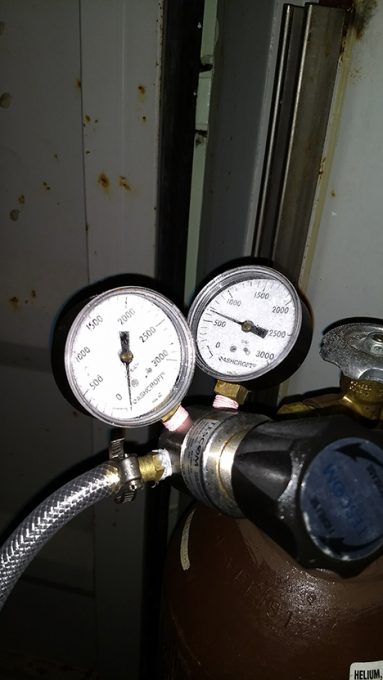
Helium tank used to fill radiosonde balloons
And the balloon … aaah well a big floppy piece of rubber… nuf said.
In addition to being useful scientifically launching these things can be challenging and fun.
If you can imagine escorting a three foot balloon madly trying to escape your grasp while flapping in 20 mile per hour winds wanting to impale itself on every pointy bit on the deck or wrap around the ship railing. Lofting it in the air only to have it flail away or come back at you and bounce off various parts of you , the ship or the water. Let’s just say each launch had its own interesting characteristic.
When the wind comes from behind the ship fast enough the balloon races ahead of the ship.
Sometimes the balloon goes horizontally for a while and then decides to deposit the sensor package unceremoniously into the ocean. In the dark, with rain and the ship bouncing at 12 knots …well you get the idea.
Here are a few of the balloon destruction surfaces .

A frame balloon target (left) and an antenna balloon target (right).
For the most part the launches are successful and a welcomed break rom other shipboard tasks.
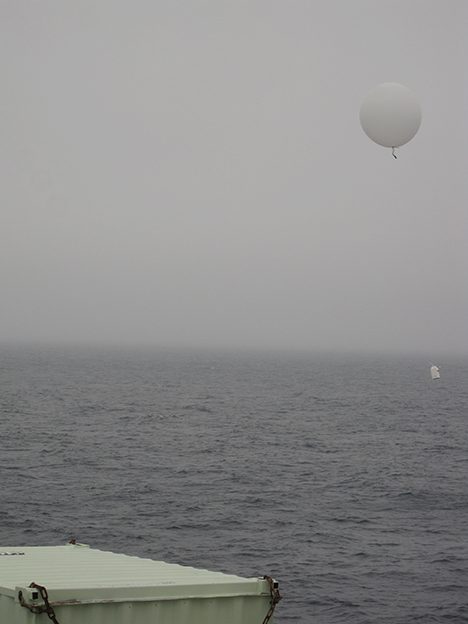
Floating radiosonde balloon after a successful launch on board the R/V Atlantis.
All good fun … but for now. A parting verse.
We are waiting to dock in with the morning high tide
Thanks to the ship’s crew for a wonderful ride
Hoping to see you all with will to defend
And instruments in hand, at the near oceans end.
Cheers,
Cyril McCormick
Life at Sea: All Science All the Time and That’s a Good Thing….well mostly.
Any cruise aboard a research vessel feels like the days of the week are blended into one. The only timekeeping that one really has to pay attention to is the hour. When is the next instrument to be deployed over the side of the ship? When do the experiments need to be sampled again? When can I have a nap? A snack? The schedule is all science, all the time, and it’s awesome.
The R/V Atlantis is a state-of-the-art floating laboratory that has everything we need to succeed, from instrumentation and over the side equipment to highly skilled technical staff, officers and crew. It’s the perfect platform to promote and support scientific productivity for large projects like the North Atlantic Aerosols and Marine Ecosystems Study (NAAMES). During this four week research cruise the ship has hosted 13 different research groups, each studying different aspects of marine physics, chemistry, biology and atmospheric science. Linking them all is the context of a bloom forming ecosystem, the North Atlantic. The interdisciplinary nature of this cruise has forced everyone to leave their smaller focused research “boxes” and think about how the questions and approaches of other subdisciplines can complement each other to address a larger question. The question in this case being, “how do the biological and ecosystem processes associated with large phytoplankton blooms affect ocean biogeochemistry and aerosol production in the North Atlantic”?

R/V Atlantis just before departure from WHOI
We are perfectly set up to tackle the question. Within a 200-foot radius cutting through North Atlantic waters, we have our sampling gear and instrumentation, well-equipped laboratories, state rooms, a galley and most importantly, interdisciplinary colleagues with whom to share ideas, debate and hone experimental designs. While life at our home institutions provides us with similar frameworks to investigate the questions we view meaningful, many of us often reflect on a busy week wondering what exactly we accomplished. That viewpoint is largely consequence of schedules being stretched thin by teaching (or taking classes), going to scheduled meetings, to impromptu meetings, and to meetings about those meetings, and then of course, writing emails, many of which are to schedule more meetings. At sea, each of us is allotted 100mb of internet connection per day (about 10 minutes of access on a home network), which is amazing because 1) we can access the internet in one of the most remote places in the world and 2) internet activity is short, to the point, and without frivolous lingering on social media. It is nice to be able to communicate with family and friends at home, but the limited access to the internet means that the majority of our energy is spent on research activities.
The only meetings we attend are regular science briefings designed to discuss the science conducted onboard, to prepare for upcoming over-the-side operations, to consider changes to the ship course, and to be informed about changing weather patterns and sea state. These consume fractions of our days, leaving most of the hours available for science operations. Sleep has been hard to come by, but time at sea is such a rare opportunity that the objective is always to get as much done as humanly possible and worry about sleep later. To give this some context, our group’s research focuses on the microbial degradation, or decomposition, of organic matter in the vertical oceanic water column. Part of our research requires us to conduct microbial incubation experiments that are run over a week to a month. In our land-based laboratories, we might be successful in conducting five to ten of these experiments over the course of a three month period. Out here, we are finishing up our 30th microbial degradation experiment in three weeks.

Regular science briefing aboard the NAAMES cruises.
This effort requires significant multitasking and planning and is only feasible because of the lack of distraction that comes from the regular day-to-day life. This mode of operation is certainly not sustainable over the long-term, but in short (weeks) burst, it has proven to be very productive. Though these research cruises are not designed for pleasure, they provide us with the time to focus on the work we love, to interact with interdisciplinary scientists of similar interests, and to appreciate the mysteries of the natural world, reminding us why we push ourselves to do what we do.
Written by Craig A. Carlson and Nicholas Q. Huynh